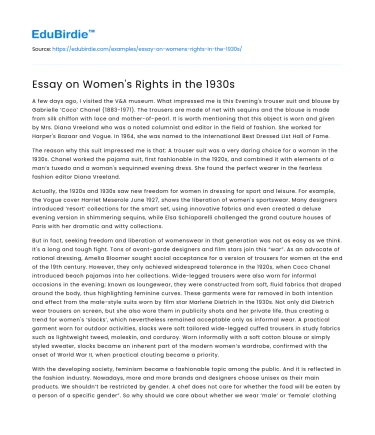A few days ago, I visited the V&A museum. What impressed me is this Evening's trouser suit and blouse by Gabrielle ‘Coco’ Chanel (1883-1971). The trousers are made of net with sequins and the blouse is made from silk chiffon with lace and mother-of-pearl. It is worth mentioning that this object is worn and given by Mrs. Diana Vreeland who was a noted columnist and editor in the field of fashion. She worked for Harper's Bazaar and Vogue. In 1964, she was named to the International Best Dressed List Hall of Fame.
The reason why this suit impressed me is that: A trouser suit was a very daring choice for a woman in the 1930s. Chanel worked the pajama suit, first fashionable in the 1920s, and combined it with elements of a man’s tuxedo and a woman's sequinned evening dress. She found the perfect wearer in the fearless fashion editor Diana Vreeland.
Save your time!
We can take care of your essay
- Proper editing and formatting
- Free revision, title page, and bibliography
- Flexible prices and money-back guarantee
Actually, the 1920s and 1930s saw new freedom for women in dressing for sport and leisure. For example, the Vogue cover Harriet Meserole June 1927, shows the liberation of women's sportswear. Many designers introduced ‘resort’ collections for the smart set, using innovative fabrics and even created a deluxe evening version in shimmering sequins, while Elsa Schiaparelli challenged the grand couture houses of Paris with her dramatic and witty collections.
But in fact, seeking freedom and liberation of womenswear in that generation was not as easy as we think. It's a long and tough fight. Tons of avant-garde designers and film stars join this “war”. As an advocate of rational dressing, Amelia Bloomer sought social acceptance for a version of trousers for women at the end of the 19th century. However, they only achieved widespread tolerance in the 1920s, when Coco Chanel introduced beach pajamas into her collections. Wide-legged trousers were also worn for informal occasions in the evening; known as loungewear, they were constructed from soft, fluid fabrics that draped around the body, thus highlighting feminine curves. These garments were far removed in both intention and effect from the male-style suits worn by film star Marlene Dietrich in the 1930s. Not only did Dietrich wear trousers on screen, but she also wore them in publicity shots and her private life, thus creating a trend for women's ‘slacks’, which nevertheless remained acceptable only as informal wear. A practical garment worn for outdoor activities, slacks were soft tailored wide-legged cuffed trousers in study fabrics such as lightweight tweed, moleskin, and corduroy. Worn informally with a soft cotton blouse or simply styled sweater, slacks became an inherent part of the modern women’s wardrobe, confirmed with the onset of World War II, when practical clouting became a priority.
With the developing society, feminism became a fashionable topic among the public. And it is reflected in the fashion industry. Nowadays, more and more brands and designers choose unisex as their main products. We shouldn’t be restricted by gender. A chef does not care for whether the food will be eaten by a person of a specific gender”. So why should we care about whether we wear ‘male’ or ‘female’ clothing? If you like a piece of clothing and it fits in the way you intended, buy it – gender shouldn’t come into it. The only thing we should care about gender is just the cutting and tailoring, but not the design. This is respect for human differences.






 Stuck on your essay?
Stuck on your essay?

